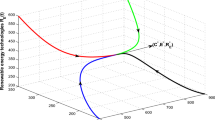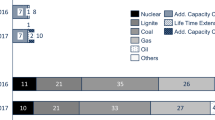Abstract
This paper evaluated the impacts of climate change mitigation technology options on CO2 emission reductions and the effects of model representations regarding renewable intermittency on the assessment of reduction by using a world energy systems model. First, different diffusion scenarios for carbon dioxide capture and storage (CCS), nuclear power, and wind power and solar PV are selected from EMF27 scenarios to analyze their impacts on CO2 emission reductions. These technologies are important for reducing CO2 intensity of electricity, and the impacts of their diffusion levels on mitigation costs are significant, according to the analyses. Availability of CCS in particular, among the three kinds of technologies, has a large impact on the marginal CO2 abatement cost. In order to analyze effects of model representations regarding renewables intermittency, four different representations are assumed within the model. A simplistic model representation that does not take into consideration the intermittency of wind power and solar PV evaluates larger contributions of the energy sources than those evaluated by a model representation that takes intermittency into consideration. Appropriate consideration of renewables intermittency within global energy systems models will be important for realistic evaluations of climate change mitigation scenarios.




Similar content being viewed by others
Explore related subjects
Discover the latest articles and news from researchers in related subjects, suggested using machine learning.References
Akimoto K et al (2010) Estimates of GHG emission reduction potential by country, sector, and cost. Energy Policy 38(7):3384–3393
Akimoto K et al (2012) Consistent assessments of pathways toward sustainable development and climate stabilization. Nat Res Forum 36(4):231–244
EC (2010) Communication from the comission to the european parlizament, the council, the european economic and social committee and the committee of the regions: Energy infrastructure priorities for 2020 and beyond—a blueprint for an integrated european energy network, COM(2010) 677 final
Edenhofer O et al (2010) The economics of low stabilization: model comparison of mitigation strategies and costs. Energy J 31(Special Issue1):11–48
Flannery B (2011) Comment to the article by H.J. Herzog. Energy Econ 33(4):605–607
Fripp M (2012) Switch: a planning tool for power systems with large shares of intermittent renewable energy. Environ Sci Technol 46(11):6371–6378
GE Energy (2010) Western wind and solar integration study report, subcontract report NREL/SR—550-47434. Nationial Renewable Energy Laboratory, USA
Georgilakis P (2008) Technical challenges associated with the integration of wind power into power systems. Ren Sustain Energy Rev 12:852–863
Holttinen et al (2009) Design and operation of power systems with large amounts of wind power, final report, IEA WIND Task 25, Phase one 2006–2008
IEA (2012) Energy balances of non-OECD countries, OECD/IEA
IPCC (2007) Climate change 2007: the physical science basis. Cambridge University Press, Cambridge
IPCC (2011) Special report on renewable energy sources and climate change mitigation. Cambridge University Press, New York
Japanese government committee on electricity supply and demand (2013) http://www.meti.go.jp/committee/sougouenergy/sougou/jukyu_kensho/pdf/003_04_00.pdf. (in Japanese)
Kassakian J et al (2011) The future of the electric grid. Interdiscliplinary MIT study
Komiyama R, Fujii Y (2012) Assessmkent of Japan’s optimal power generation mix considering massive deployment of variable renewable power generation. IEEJ Trans Power Energy 132(7):639–647 (in Japanese)
Kriegler E et al (2013) The role of technology for achieving climate policy objectives: overview of the EMF27 study onglobal technology strategies and climate policy scenarios. Clim Chang, this issue
Luderer G et al (2012) Asia’s role in mitigating climate change: a technology and sector specific analysis with ReMIND-R. Energy Econ 34(S3):S378–S390
Luderer G et al (2013) The role of renewable energy in climate stabilization: results from the EMF27 scenarios. Clim Chang, this issue
Milligan M, Porter K (2008) Determining the capacity value of wind: an updated survey of methods and implementation, presented at WindPower 2008, Houston, USA
Milligan M et al (2009) Large-scale wind integration studies in the United States: preliminary results, presented at the 8th international workshop on large scale integration of wind power and on transmission networks for offshore wind farms, Bremen, Germany
Oda J, Akimoto K (2011) An analysis of CCS investment under uncertainty. Energy Procedia 4:1997–2004
Sorrel S et al (2000) Reducing barriers to energy efficiency in public and private organizations. Final report to the European comission
Tavoni M et al (2011) The value of technology and of its evolution towards a low carbon economy. Clim Chang 114:39–57
Author information
Authors and Affiliations
Corresponding author
Additional information
This article is part of the Special Issue on “The EMF27 Study on Global Technology and Climate Policy Strategies” edited by John Weyant, Elmar Kriegler, Geoffrey Blanford, Volker Krey, Jae Edmonds, Keywan Riahi, Richard Richels, and Massimo Tavoni.
Electronic supplementary material
Below is the link to the electronic supplementary material.
ESM 1
(DOCX 164 kb)
Rights and permissions
About this article
Cite this article
Sano, F., Akimoto, K. & Wada, K. Impacts of different diffusion scenarios for mitigation technology options and of model representations regarding renewables intermittency on evaluations of CO2 emissions reductions. Climatic Change 123, 665–676 (2014). https://doi.org/10.1007/s10584-013-0896-z
Received:
Accepted:
Published:
Issue Date:
DOI: https://doi.org/10.1007/s10584-013-0896-z




